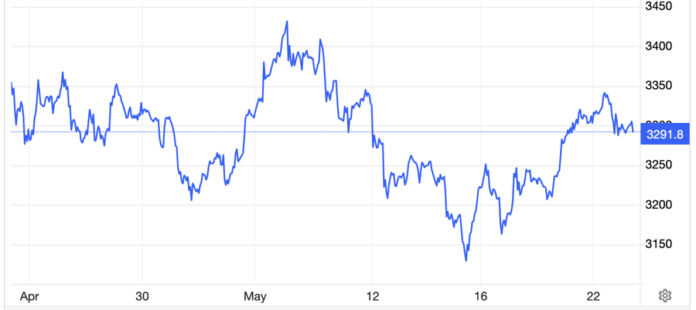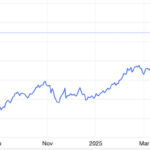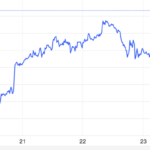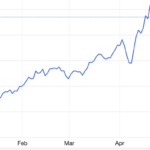Global gold prices dipped during Thursday’s trading session (May 22nd), failing to hold the $3,300 per ounce mark, as a stronger US dollar and profit-taking by some investors weighed on the precious metal. Gold prices had rallied to a two-week high earlier in the week, and some reports suggest that the retreat found solid support at the $3,300 level, with the potential for a surge to $4,000 per ounce later in the year.
At the close of trading in New York, spot gold prices ended the day at $3,296.70 per ounce, reflecting a loss of $18.80, or 0.6% from the previous session’s close, according to data from Kitco Metals. Earlier in the day, prices touched their highest level since May 9th.
On the COMEX exchange, gold futures for June delivery settled down 0.6% at $3,294.90 per ounce.
As of 8:40 a.m. Vietnam time on Friday (May 23rd), gold prices in Asian trading had rebounded, with spot gold up by $2.70, or 0.08%, changing hands at $3,299.40 per ounce. When converted to Vietnamese dong using Vietcombank’s selling exchange rate, this price equates to approximately 104 million dong per tael, representing a decrease of 1.3 million dong from the previous day’s rate.
The recovery of the US dollar on Thursday exerted downward pressure on gold prices, with the Dollar Index, which measures the greenback against a basket of six major currencies, settling near the 100 level, reflecting a 0.3% gain.
Additionally, gold prices were impacted by profit-taking activities as investors locked in gains following three consecutive days of increases since the beginning of the week.
“Today’s session witnessed some profit-taking after the recent gains,” remarked senior analyst Jim Wyckoff of Kitco Metals, adding, “A stronger US dollar was also a negative factor for the gold market.”
However, Wyckoff affirmed that the ongoing volatility in global bond markets, particularly US Treasury bonds, would continue to drive safe-haven demand for gold as a hedge against inflation risks.
On Thursday, the US House of Representatives passed a bill that includes extending the tax cuts implemented by President Donald Trump in 2017 and increasing military spending. The Republican-led legislation has now been sent to the Senate for approval.
Analysts predict that this bill will further escalate the federal budget deficit and add trillions of dollars to the national debt over the next decade, coinciding with a potential return of inflationary pressures due to Trump’s tariff policies. These concerns have weighed on US Treasury bond prices in recent sessions, driving yields higher. The Congressional Budget Office (CBO) estimates that if enacted, the bill will cost nearly $4 trillion.
Yields on 30-year US Treasury bonds surged to 5.161% during Thursday’s session, reaching their highest level since 2023, before retreating slightly to close at 5.05%. Yields on the benchmark 10-year bonds also rose sharply before reversing course to end the day at 4.54%.
In addition to the sell-off in US Treasury bonds, investors also offloaded government bonds in major markets such as Germany and Japan.
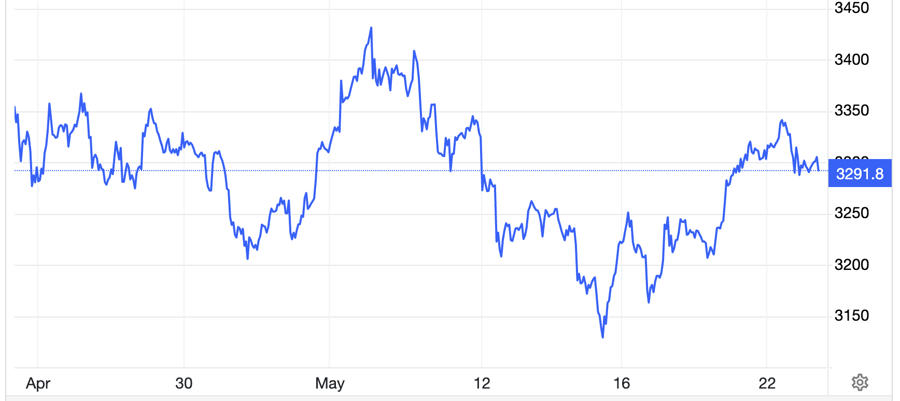
Moreover, the demand for safe-haven assets remains elevated due to lingering trade war concerns, despite a recent easing of tensions. Gold prices soared to record highs above $3,500 per ounce last month following Trump’s announcement of retaliatory tariffs.
According to Zain Vawda, an analyst at Oanda, a data and analysis firm, the Trump administration could announce trade deals with some partners in the coming weeks, and the content of these agreements may play a crucial role in shaping gold price movements for the remainder of the year.
On Friday morning, the US dollar weakened again, indicating persistent downward pressure on the greenback due to concerns over Trump’s policies. The Dollar Index fell by nearly 0.3% to 99.69 at one point during the Asian trading session.
In a recent report, portfolio manager Imaru Casanova of the VanEck Gold and Precious Metals Fund noted that during this accumulation phase, gold prices appear to have established a solid foundation around the $3,000 level. Casanova also stated that the sharp decline from the record high of $3,500 per ounce to the current levels is not surprising.
According to the report, the current allocation to gold by global asset managers remains low, at approximately 1%, despite gold’s impressive performance in recent years, with a 27% gain in 2024 and a rise of over 20% so far in 2025. Casanova recommends a strategic allocation to gold of around 5%. She also suggested that based on the historical correlation between gold prices and gold ETF holdings, gold prices need to increase by an additional $600 per ounce.
In a separate report, analysts from VanEck predicted that gold prices could reach the $4,000 per ounce level this year.
On Thursday, the world’s largest gold-backed ETF, SPDR Gold Trust, purchased nearly 4 tons of gold, increasing its holdings to almost 923.9 tons. This marks a shift from the previous four weeks, during which the fund had been net sellers, as it turned net buyers this week.
The Golden Opportunity: Unveiling the Rising Trend of Gold Ring Prices on May 22nd
The gold ring price this afternoon, May 22, at some brands, still surged by an average of VND 200,000 to VND 500,000 per tael compared to the opening of the trading session this morning.
“Investors Lose Hundreds of Millions in a Matter of Days: The Risky Business of Gold”
“Once considered a ‘safe haven’, gold is now a volatile asset. In today’s ever-changing economic landscape, the value of gold is subject to rapid fluctuations, making it an uncertain investment choice. With global markets in a constant state of flux, investors are seeking more stable havens for their wealth.”

